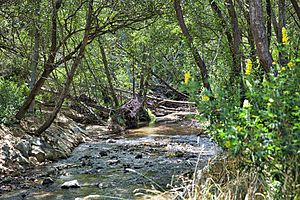Butano Creek facts for kids
Quick facts for kids Butano Creek |
|
|---|---|

A portion of the Butano Creek Restoration Project, located above Pescadero, California. USFWS Photo/Steve Martarano.
|
|
| Other name(s) | Arroyo del Butano |
| Country | United States |
| State | California |
| Region | San Mateo County |
| Physical characteristics | |
| Main source | South of Butano Ridge at China Grade in the Santa Cruz Mountains 2,120 ft (650 m) 37°13′00″N 122°13′25″W / 37.21667°N 122.22361°W |
| River mouth | Pescadero Creek in Pescadero Marsh Pescadero, California 0 ft (0 m) 37°16′01″N 122°24′43″W / 37.26694°N 122.41194°W |
Butano Creek is a stream about 15 miles (24 km) long in San Mateo County, California. It carries a lot of water from the Santa Cruz Mountains. This water flows into the Pacific Ocean. It joins the Pescadero Creek delta at Pescadero Marsh near the town of Pescadero.
Contents
History of Butano Creek
The name "Butano" has an interesting past. According to Frances M. Molera, "butano" was a word early Californians used. It meant a drinking cup made from an animal's horn, like a bull's horn.
The first time "El Butano" was written down was on July 7, 1816. This was by Padre Jaime Escudet. A map from 1833 showed "Arollo del Butano," which means "Butano Stream." Later, land grants called "El Butano" were made in 1838 and 1844. These grants also mentioned a "Bolsa del Butano," meaning "Butano Pocket."
Where Butano Creek Flows
Butano Creek starts high up in the Santa Cruz Mountains. Its source is just above the line between San Mateo County and Santa Cruz County. It begins at a bend in China Grade Road, at the south end of Butano Ridge.
As the creek flows, other smaller creeks join it. First, the South Fork Butano Creek flows in from the left side. Then, Little Butano Creek also joins from the left. Most of Little Butano Creek is protected inside Butano State Park.
Animals and Nature in Butano Creek
Butano Creek was once home to many fish. These included steelhead trout (Oncorhynchus mykiss) and coho salmon (Oncorhynchus kisutch). These fish would swim upstream to lay their eggs.
However, by 2003, coho salmon were no longer returning to Butano or Pescadero Creeks. About 17,000 hatchery-raised coho were released into Pescadero Creek that year. But only three of their offspring were counted in 2015. Even though a few dead salmon have been found, coho salmon are now very rare in the Butano area.
Why the Creek Changed
Problems for the creek started around 1923. This was when the Santa Cruz Lumber Co. built a sawmill near Pescadero Creek. Loggers cut down many coast redwood and coast Douglas-fir trees. This caused a lot of soil and mud, called silt, to wash into the creek.
Farms along the creeks also added to the silt runoff. By the early 1990s, a thick layer of silt blocked Butano Creek. This blockage separated the upper part of the creek from the lower part.
Fixing the Creek
Because the creek was blocked, roads and farmland often flooded almost every year. The backed-up water sometimes reached homes in Pescadero, about 2 miles (3.2 km) away. People there often had to use sandbags to protect their homes.
In 2019, a big project began to fix this problem. The San Mateo County Resource Conservation District led the $7 million project. They worked with California State Parks to dig out about 4,000 feet (1,200 meters) of Butano Creek. This helped to reconnect the creek to its natural floodplain. It also removed the silt plug that was stopping the salmon from moving freely.
Fun Things to Do
If you like nature, you might enjoy Camp Butano Creek. This is a Girl Scout camp located in the wooded foothills of the Santa Cruz Mountains. The camp is near the town of Pescadero. It also borders Butano State Park, offering a great outdoor experience.

